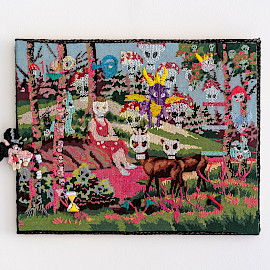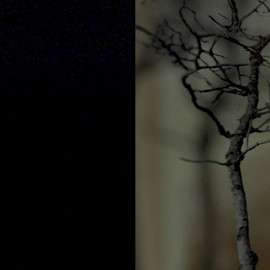Previous exhibitions
Art Center Ahjo, Hehku- , Kytö- and Liekki -space: Virpi Vesanen-Laukkanen, Leena Illukka, Silja Puranen
Art Center Ahjo, Hehku- , Kytö- and Liekki -space: Virpi Vesanen-Laukkanen, Leena Illukka, Silja Puranen
1.11.-19.11.
The group exhibition of three artists combines storytelling and perspectives on being human. The ensemble, consisting of video and textile works, comments on the ever-accelerating changes taking place in society and the environment, the sprains, strains and fractures they produce. The starting point for working is the individual's relationship with nature, culture and social structures. The group has held exhibitions since 2018. Now their twelfth joint exhibition is on display in the Kytö, Liekki and Hehku spaces.
Leena Illuka's Kir(j)otut Säannöt -works combine traditional embroidery with the iconic images of console games. Recycled wall textiles serve as the screen for the game. In these tragicomic, soft and silent works, different worlds coexist in imagery and techniques. Digital games meet traditional craftsmanship and breaking its tradition. For example, Dream Lover -works are based on traditional emproidery. These soft “love simulation games” deal with the balancing act between people and daily life.
Silja Puranen's work deals with humanitys relationship with the environment. The Nightingale/Satakieli is a two-channel video work, in one of which there are animated skewed plastic birds – decorations, toys and music boxes – and in the other an aerial acrobat fighting against gravity. A cacophonous chorus of the plastic birds sings of humanitys desire to outdo nature with artificial imitations while a machine voice reads excerpts from H.C. Andersen's The Nightingale fairy tale.
Virpi Vesanen-Laukkanen's Poly Esters -works are made of polyester clothes. The oldest of them remind us of the time of (consumption) optimism. Wash and keep -clothes represented a carefree, urban lifestyle in the 1960s. Polyester is a plastic that can be partially recycled as material for new products. When recycled as clothes, however, it often ends up as a filling material or other inferior product. Vesanen-Laukkanen uses whole clothes in her works, rolls and attaches them to each other and returns them for reuse at the end of the Poly Esters -project.



